Verdict
You can buy amps that do more than the 641 but, used to its strengths, very few rivals can touch the even-handed musical brilliance on display here.
Pros
- Sound absolutely brilliant
- Fabulous build
- A pleasure to use and live with
Cons
- No headphone socket or phono preamp
- No preout
- Not cheap
Introduction
The Moon 641 is the flagship integrated amplifier in the company’s range and the only integrated amp in the company’s North Collection of components. This range represents everything that the company knows about making audio equipment and takes their design philosophy and ideals and refines them to their ultimate conclusion.
On paper at least, the specification that the Moon 641 offers is good… but not spectacular. It doesn’t offer the sort of output that allows it to double as a welder and there are more lavishly equipped rivals vying for your attention.
This is not about Moon playing a numbers game. Instead the idea is that you sit down to listen to them and are won over by the entire experience that they generate. It’s a bold strategy when considering that price but Moon has a formidable reputation so if anyone can do it, they can.
Availability
The Moon 641 amp costs £11,000. As you might expect, it is the preserve of specialist dealers able to support and demonstrate devices of this nature. It is distributed reasonably evenly across the UK so, while you might not have an outlet for a 641 on your local high street, neither should you have to make a holiday of it to get a listen.
Simaudio is a Canadian company and handles its own sales in North America which means that the 641 has a dollar to pound parity in their pricing because there is an extra layer of (very professional) distribution in the UK. The company has distribution in Australia where the 641 can be purchased for AUD$19,000.
As you might expect, the high-end bristles with competition to these units and while the specification of the 641 is impressive in an engineering sense, you can buy integrated amplifiers that offer a wider spread of functionality than this if you wish to.
Design
- All metal, two tone casework
- Full colour display
- Bespoke remote
The North Collection takes styling cues from more terrestrially priced Moon products and proceeds to use them in the creation of a range of components that feel pretty special, even when you take their asking price into account.
There are objects that have been shot into space, taken a trip to the ocean depths or that we rely on for national security purposes that are not as solidly bolted together as the 641 is.
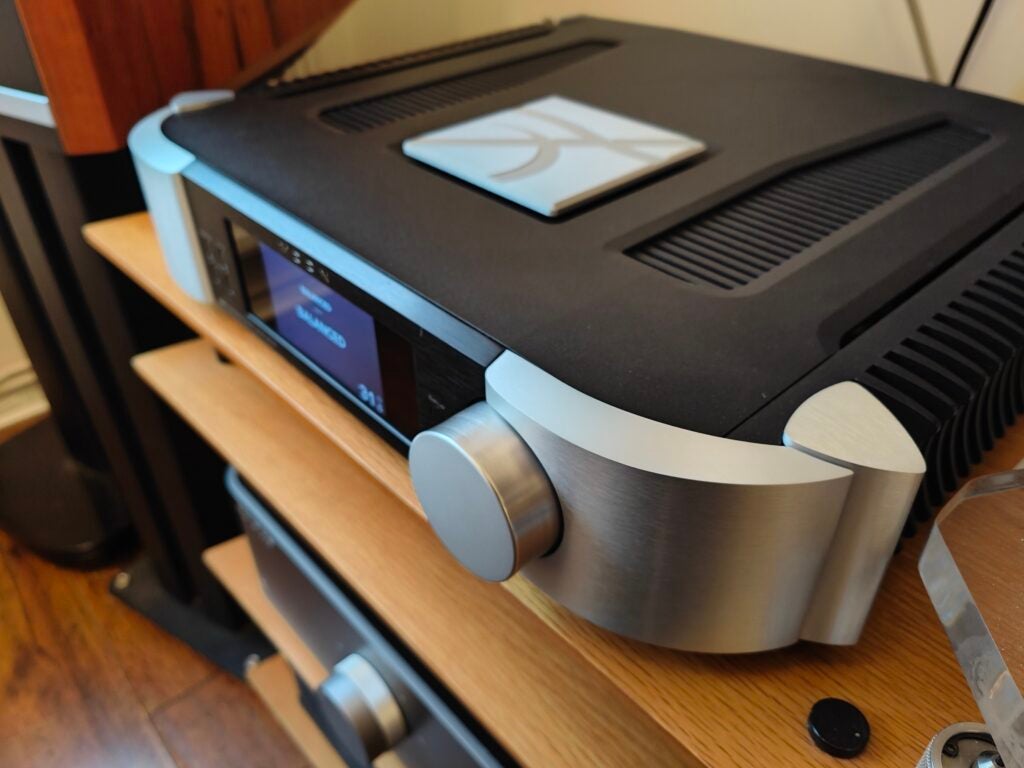
Everything feels like it has been assembled as well as it can be done rather than the best it can be done for a given price point. The casework incorporates both black and silver elements in a way that means they look brilliant when you go all in but, interestingly, will also sit happily in a system otherwise made of one of those two colours. You don’t have to know anything about the audio industry to know that this is a premium bit of kit.
The design also hints at the fact that this is not a completely minimalist device either. At the front you’ll find a large colour display that shows what the amp is up to (and, choosing my words carefully, can be read by the sort of person at an age where they might drop 11 grand on an amp).
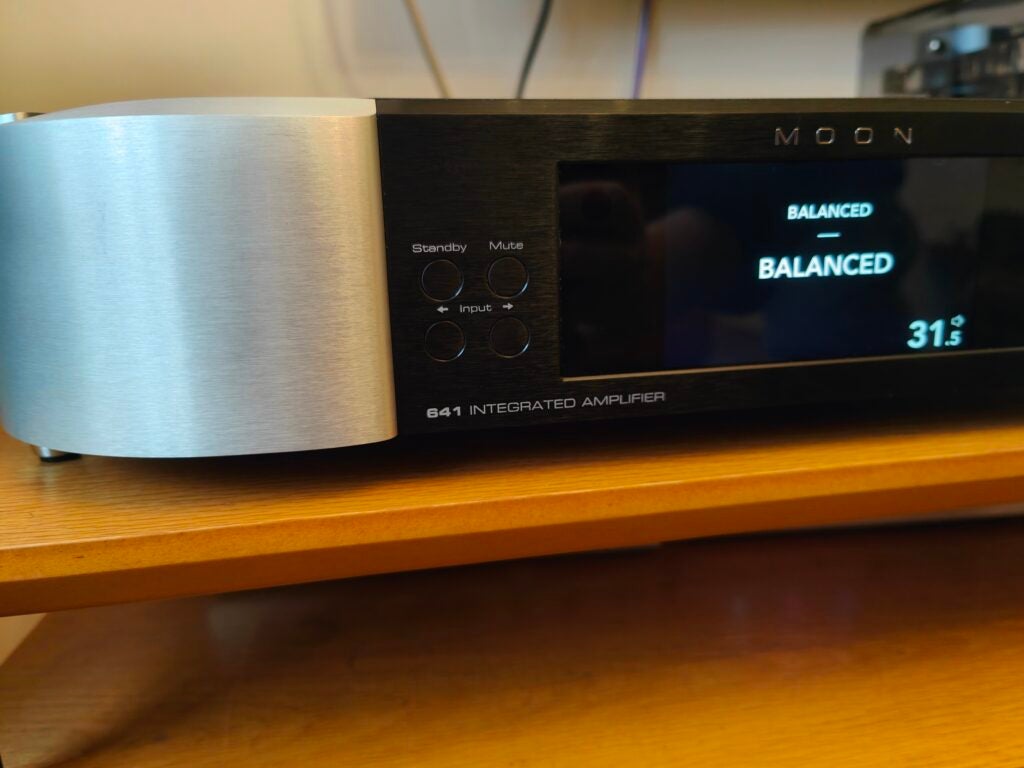
This shows volume and input on the amp as well as allowing for settings to be adjusted. These settings extend to adjusting the display background which you’ll want to do as the plain black looks far classier than the option with the circuit board overlay.
Mention must be made of the remote control too. It’s called the BRM-1 and it’s a thing of great loveliness. When you pair it with the 641 it gives feedback on volume and input on a small display and is largely adjusted by a beautifully weighted rotary cuff that mimics the feel of the equally fastidious volume control on the amp itself.
It makes most supplied remote handsets feel like toys and ensures that some of the quality feel of the Moon 641 makes it back to the listening position.

Features
- 125 watt amplifier with distortion reduction technology
- Balanced and unbalanced connections
- Useful system integration.
The 641 amplifier is a relatively simple device, but this is strictly in a functionality sense rather than design one. This a line level integrated amplifier that offers a single balanced input and four RCA connections. There is a line level output and a pair of enormously solid speaker terminals and that is basically your lot.
This might seem parsimonious; the 641 does less in a features sense than the company’s most affordable integrated amplifier, but it reflects that the way Moon divides responsibility across its products is to have digital sources do the heavy lifting and let the amp be an amp.
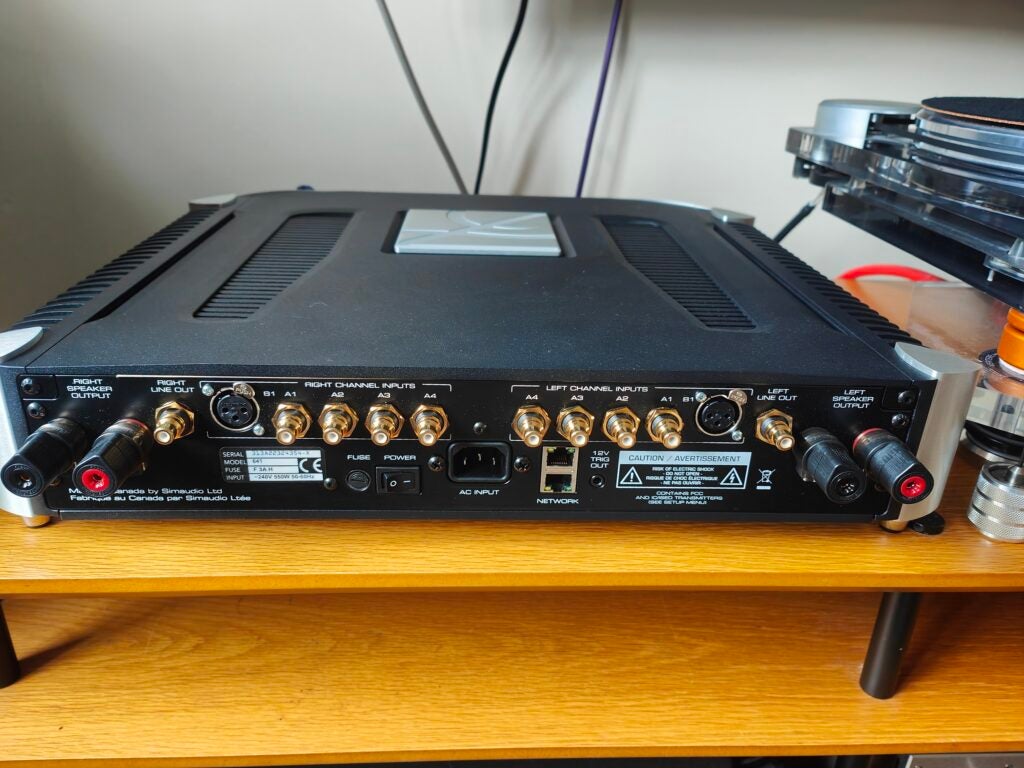
And, make no mistake, the large casework is absolutely chock full of amplifier. The 641 has two large toroidal power supplies, one for each channel and the whole amp is laid out in a dual mono configuration to ensure that crosstalk is kept to a minimum (which is why the input board has the slightly unusual layout it has too).
It also uses a system called MDCA (MOON Distortion-Cancelling Amplifier) to avoid having to use any form of feedback circuit which ensures that the measured performance is very good indeed. The 125-watt output into 8 ohms doesn’t sound huge but it doubles into 4 ohms and the 641 hasn’t had to exert itself to hit any volume level I’ve asked for here.
The only slight oddity here is that the 641 has no form of preout, which is going to make sub integration harder and means you can’t upgrade to any of the power amp options in the North Collection without buying a preamp too. There is also no phono stage or headphone socket, but Moon does make excellent examples of these albeit not in the North Collection (although ‘non North’ components look sufficiently similar that it’s not the end of the world).
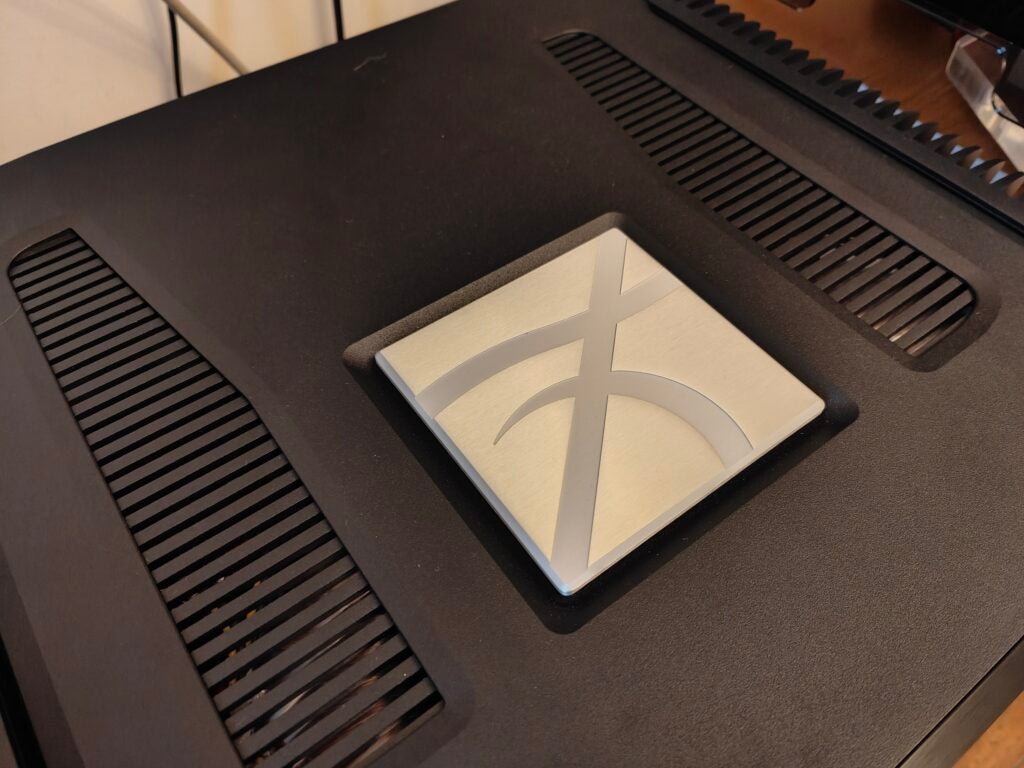
The relatively lean fitment of the 641 makes rather more sense when you look at the functionality of the company’s source equipment which tends to offer both streaming and additional digital inputs meaning if you go all in on North Collection equipment, they get an awful lot done. This ability is enhanced by the 641’s control links that allow it to run via a single control point.
Sound Quality
- Outstanding sense of tonality
- Well-controlled bass output
- Revealing sense of detail
Moon is not and never has been a company interested in blowing you away in the first few seconds of listening. All of the nigh on obsessional effort that has gone into the 641 has been in the pursuit of realism and accuracy rather than something you use to impress your mates from time to time and then ignore for the rest of it. If that sounds underwhelming, it really, really shouldn’t. Allow me to (try and) explain.
Connected to the Kudos Titan 505 speakers that live here for test work and with which I am intimately familiar, the way in which the Moon 641 sets about Burn Out by the Cinematic Orchestra is both extremely appealing and enormously instructive. I have heard the track many thousands of times over the years, and I’ve heard it on some serious hardware. Even so, there are still elements to what is happening here that are noteworthy.
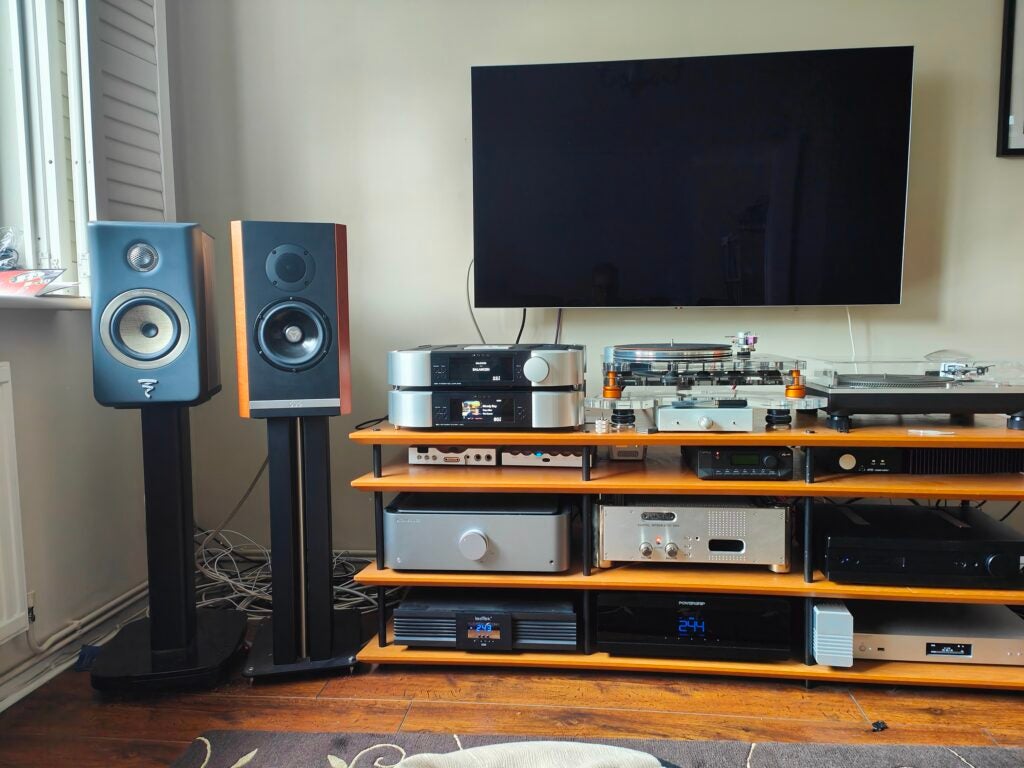
The first that the tonality is truly outstanding. Its unembellished and absolutely even across the frequency response but, with a well recorded album like this, it is utterly compelling. This is not an amplifier seeking to add anything to the listening experience but instead it effortlessly ensures that everything on the recording is offered up in perfect proportion and made available to you. It’s done in such an understated way that sometimes, it’s only when you listen to the same material on something else that you realise how well the 641 is doing.
This is perfectly demonstrated in the bass response. It’s so well integrated into the rest of the frequency response and so beautifully controlled, you can kid yourself that the flurry of low end on Telephasic Workshop by Boards of Canada isn’t as deep as it is on some other systems. Listen again and you realise that it is, but the complete lack of overhang or sluggishness makes the Moon sound leaner than it is. In reality, it hits very hard indeed, it’s just doing so with astonishing dexterity.
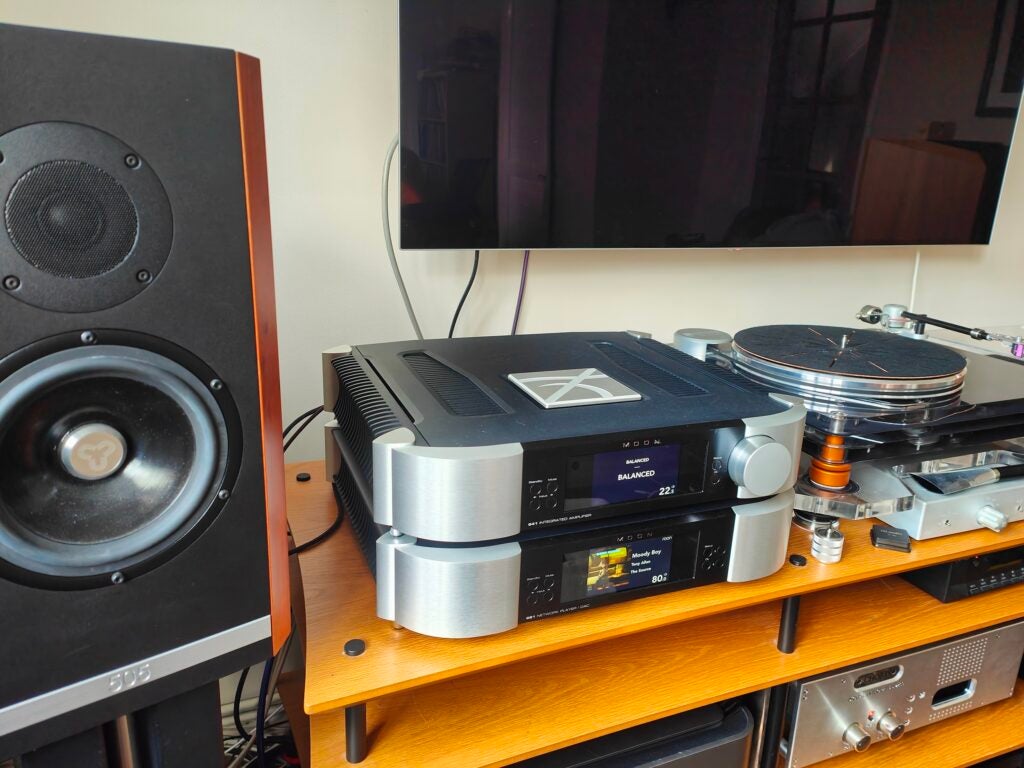
Tested via both the matching 681 Streamer and with my resident Chord Electronics Hugo Mscaler and TT2 pairing, the 641 has demonstrated some consistent traits; I’m not sure that Moon would like me using the word ‘personality’ because it suggests a level of colouration that isn’t really present. This is an amplifier trying hard not to be the story but instead doing everything it can to let the music happen. For something as consistently revealing as it is, I’ve also found it to be commendably forgiving of less than perfect material. It’s fast and energetic but never at the expense of forcing slower material.
One final area I’ve found that 641 to excel is with vinyl. The clean and uncoloured sound means that the tonal balance of a turntable front end is delivered with no additional character creeping in.
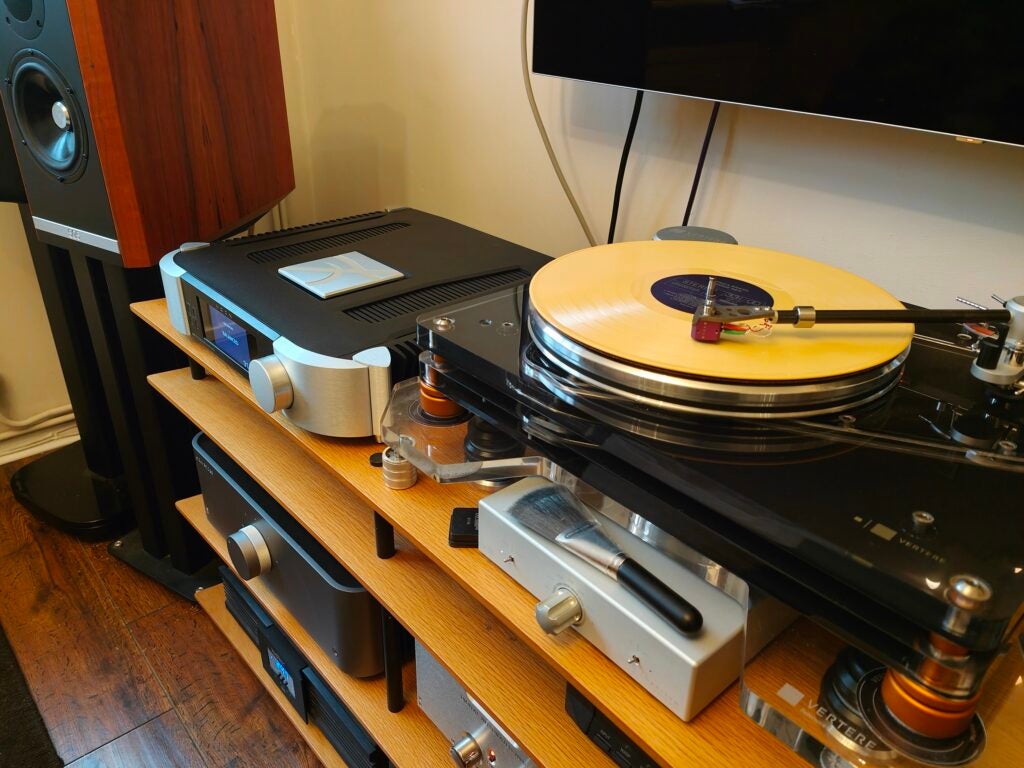
I had a very enjoyable blast through the newly released ‘Zero Gravity’ version of the original PS1 Wipeout soundtrack (yes, I bought a 28-year-old computer game soundtrack on vinyl) and the drive and impact of the 641 was a joy from start to finish.
The 125-watt power output might not be huge on paper, but I’ve also found no shortage of headroom even when running cartridge and phono stage combinations with limited gain. If you are already happy with the tonal balance of your system, the Moon 641 is going to boost its capability without altering the aspects you already like.
Latest deals
Should you buy it?
Real world brilliance
The 641 is a demonstration of going beyond telephone number power outputs and a socket for every occasion. It does a specific set of functions but does them staggeringly well. It will drop into a huge range of systems and complement them all while allowing for pretty much free reign in speaker choice thanks to the effortless power delivery.
Bare bones
Many integrated amplifiers at this price do a fair bit more than the 641, be it having a phono stage and headphone amp or being most of the way to a full all-in-one system. The 641 is a lot of money in its own right and needs a fair bit of supporting equipment to show what it can do.
Final Thoughts
The 641 is a fairly pricey thing and it will need decent sources and speakers to truly make the investment worthwhile. Work with it though and it can deliver a truly spectacular performance that combines impressive neutrality and clarity with a level of build and finish that even competition at the price struggles to match.
How we test
We test every amplifier we review thoroughly over an extended period of time. We use industry standard tests to compare features properly. We’ll always tell you what we find. We never, ever, accept money to review a product.
Find out more about how we test in our ethics policy.
FAQs
You can’t connect a subwoofer to the Moon 641 as it doesn’t have a sub out connection.
Verdict
You can buy amps that do more than the 641 but, used to its strengths, very few rivals can touch the even-handed musical brilliance on display here.
Pros
- Sound absolutely brilliant
- Fabulous build
- A pleasure to use and live with
Cons
- No headphone socket or phono preamp
- No preout
- Not cheap
Introduction
The Moon 641 is the flagship integrated amplifier in the company’s range and the only integrated amp in the company’s North Collection of components. This range represents everything that the company knows about making audio equipment and takes their design philosophy and ideals and refines them to their ultimate conclusion.
On paper at least, the specification that the Moon 641 offers is good… but not spectacular. It doesn’t offer the sort of output that allows it to double as a welder and there are more lavishly equipped rivals vying for your attention.
This is not about Moon playing a numbers game. Instead the idea is that you sit down to listen to them and are won over by the entire experience that they generate. It’s a bold strategy when considering that price but Moon has a formidable reputation so if anyone can do it, they can.
Availability
The Moon 641 amp costs £11,000. As you might expect, it is the preserve of specialist dealers able to support and demonstrate devices of this nature. It is distributed reasonably evenly across the UK so, while you might not have an outlet for a 641 on your local high street, neither should you have to make a holiday of it to get a listen.
Simaudio is a Canadian company and handles its own sales in North America which means that the 641 has a dollar to pound parity in their pricing because there is an extra layer of (very professional) distribution in the UK. The company has distribution in Australia where the 641 can be purchased for AUD$19,000.
As you might expect, the high-end bristles with competition to these units and while the specification of the 641 is impressive in an engineering sense, you can buy integrated amplifiers that offer a wider spread of functionality than this if you wish to.
Design
- All metal, two tone casework
- Full colour display
- Bespoke remote
The North Collection takes styling cues from more terrestrially priced Moon products and proceeds to use them in the creation of a range of components that feel pretty special, even when you take their asking price into account.
There are objects that have been shot into space, taken a trip to the ocean depths or that we rely on for national security purposes that are not as solidly bolted together as the 641 is.

Everything feels like it has been assembled as well as it can be done rather than the best it can be done for a given price point. The casework incorporates both black and silver elements in a way that means they look brilliant when you go all in but, interestingly, will also sit happily in a system otherwise made of one of those two colours. You don’t have to know anything about the audio industry to know that this is a premium bit of kit.
The design also hints at the fact that this is not a completely minimalist device either. At the front you’ll find a large colour display that shows what the amp is up to (and, choosing my words carefully, can be read by the sort of person at an age where they might drop 11 grand on an amp).

This shows volume and input on the amp as well as allowing for settings to be adjusted. These settings extend to adjusting the display background which you’ll want to do as the plain black looks far classier than the option with the circuit board overlay.
Mention must be made of the remote control too. It’s called the BRM-1 and it’s a thing of great loveliness. When you pair it with the 641 it gives feedback on volume and input on a small display and is largely adjusted by a beautifully weighted rotary cuff that mimics the feel of the equally fastidious volume control on the amp itself.
It makes most supplied remote handsets feel like toys and ensures that some of the quality feel of the Moon 641 makes it back to the listening position.

Features
- 125 watt amplifier with distortion reduction technology
- Balanced and unbalanced connections
- Useful system integration.
The 641 amplifier is a relatively simple device, but this is strictly in a functionality sense rather than design one. This a line level integrated amplifier that offers a single balanced input and four RCA connections. There is a line level output and a pair of enormously solid speaker terminals and that is basically your lot.
This might seem parsimonious; the 641 does less in a features sense than the company’s most affordable integrated amplifier, but it reflects that the way Moon divides responsibility across its products is to have digital sources do the heavy lifting and let the amp be an amp.

And, make no mistake, the large casework is absolutely chock full of amplifier. The 641 has two large toroidal power supplies, one for each channel and the whole amp is laid out in a dual mono configuration to ensure that crosstalk is kept to a minimum (which is why the input board has the slightly unusual layout it has too).
It also uses a system called MDCA (MOON Distortion-Cancelling Amplifier) to avoid having to use any form of feedback circuit which ensures that the measured performance is very good indeed. The 125-watt output into 8 ohms doesn’t sound huge but it doubles into 4 ohms and the 641 hasn’t had to exert itself to hit any volume level I’ve asked for here.
The only slight oddity here is that the 641 has no form of preout, which is going to make sub integration harder and means you can’t upgrade to any of the power amp options in the North Collection without buying a preamp too. There is also no phono stage or headphone socket, but Moon does make excellent examples of these albeit not in the North Collection (although ‘non North’ components look sufficiently similar that it’s not the end of the world).

The relatively lean fitment of the 641 makes rather more sense when you look at the functionality of the company’s source equipment which tends to offer both streaming and additional digital inputs meaning if you go all in on North Collection equipment, they get an awful lot done. This ability is enhanced by the 641’s control links that allow it to run via a single control point.
Sound Quality
- Outstanding sense of tonality
- Well-controlled bass output
- Revealing sense of detail
Moon is not and never has been a company interested in blowing you away in the first few seconds of listening. All of the nigh on obsessional effort that has gone into the 641 has been in the pursuit of realism and accuracy rather than something you use to impress your mates from time to time and then ignore for the rest of it. If that sounds underwhelming, it really, really shouldn’t. Allow me to (try and) explain.
Connected to the Kudos Titan 505 speakers that live here for test work and with which I am intimately familiar, the way in which the Moon 641 sets about Burn Out by the Cinematic Orchestra is both extremely appealing and enormously instructive. I have heard the track many thousands of times over the years, and I’ve heard it on some serious hardware. Even so, there are still elements to what is happening here that are noteworthy.

The first that the tonality is truly outstanding. Its unembellished and absolutely even across the frequency response but, with a well recorded album like this, it is utterly compelling. This is not an amplifier seeking to add anything to the listening experience but instead it effortlessly ensures that everything on the recording is offered up in perfect proportion and made available to you. It’s done in such an understated way that sometimes, it’s only when you listen to the same material on something else that you realise how well the 641 is doing.
This is perfectly demonstrated in the bass response. It’s so well integrated into the rest of the frequency response and so beautifully controlled, you can kid yourself that the flurry of low end on Telephasic Workshop by Boards of Canada isn’t as deep as it is on some other systems. Listen again and you realise that it is, but the complete lack of overhang or sluggishness makes the Moon sound leaner than it is. In reality, it hits very hard indeed, it’s just doing so with astonishing dexterity.

Tested via both the matching 681 Streamer and with my resident Chord Electronics Hugo Mscaler and TT2 pairing, the 641 has demonstrated some consistent traits; I’m not sure that Moon would like me using the word ‘personality’ because it suggests a level of colouration that isn’t really present. This is an amplifier trying hard not to be the story but instead doing everything it can to let the music happen. For something as consistently revealing as it is, I’ve also found it to be commendably forgiving of less than perfect material. It’s fast and energetic but never at the expense of forcing slower material.
One final area I’ve found that 641 to excel is with vinyl. The clean and uncoloured sound means that the tonal balance of a turntable front end is delivered with no additional character creeping in.

I had a very enjoyable blast through the newly released ‘Zero Gravity’ version of the original PS1 Wipeout soundtrack (yes, I bought a 28-year-old computer game soundtrack on vinyl) and the drive and impact of the 641 was a joy from start to finish.
The 125-watt power output might not be huge on paper, but I’ve also found no shortage of headroom even when running cartridge and phono stage combinations with limited gain. If you are already happy with the tonal balance of your system, the Moon 641 is going to boost its capability without altering the aspects you already like.
Latest deals
Should you buy it?
Real world brilliance
The 641 is a demonstration of going beyond telephone number power outputs and a socket for every occasion. It does a specific set of functions but does them staggeringly well. It will drop into a huge range of systems and complement them all while allowing for pretty much free reign in speaker choice thanks to the effortless power delivery.
Bare bones
Many integrated amplifiers at this price do a fair bit more than the 641, be it having a phono stage and headphone amp or being most of the way to a full all-in-one system. The 641 is a lot of money in its own right and needs a fair bit of supporting equipment to show what it can do.
Final Thoughts
The 641 is a fairly pricey thing and it will need decent sources and speakers to truly make the investment worthwhile. Work with it though and it can deliver a truly spectacular performance that combines impressive neutrality and clarity with a level of build and finish that even competition at the price struggles to match.
How we test
We test every amplifier we review thoroughly over an extended period of time. We use industry standard tests to compare features properly. We’ll always tell you what we find. We never, ever, accept money to review a product.
Find out more about how we test in our ethics policy.
FAQs
You can’t connect a subwoofer to the Moon 641 as it doesn’t have a sub out connection.

























